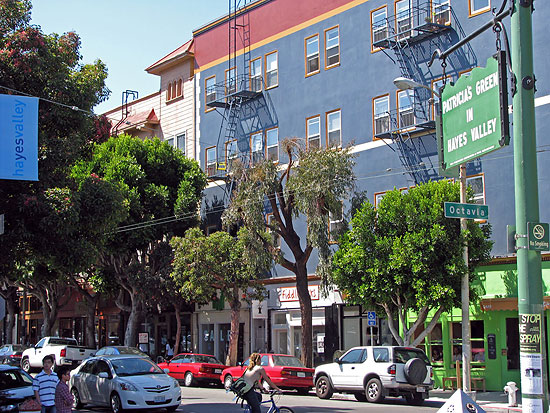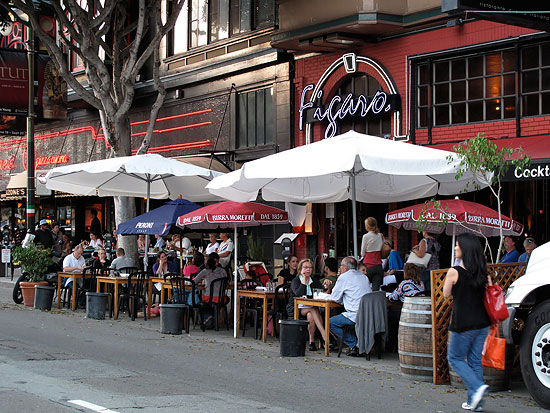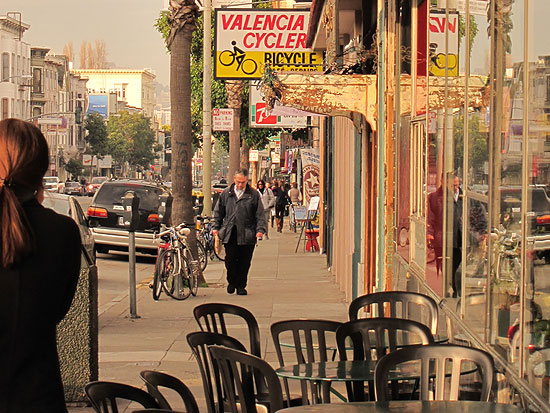
Hayes Street between Laguna and Octavia Streets is an example of a lively retail block with an uninterrupted sidewalk. Image: Flickr usersfcityscape
San Francisco is known best as a confederation of neighborhoods—at the social heart of almost every neighborhood is a retail shopping district: 24th Street in Noe Valley, Castro and Haight Streets, Irving Street in the Inner Sunset, Ocean Avenue in Ingleside, Cortland Street in Bernal Heights …
Because almost all of the city's neighborhood retail districts developed along streetcar routes—before the age of the automobile—today they retain the essential physical bones of commercial districts perfect for strolling, shopping and supporting the basic needs of neighborhood residents getting about on foot. These urban forms, augmented by a commitment to support local retailers through innovative legislation, have merged to create the local flavor of neighborhood shopping that San Francisco is known for.

Restaurants used parking spaces for outdoor seating along Columbus Avenue in North Beach on PARK(ing) Day 2009. Image: San Francisco Bicycle Coalition (Flickr user sfbike)
Lessons for planning great neighborhood streets
Plan continuous and active streetfronts that prioritize pedestrians over cars.
Maintaining a seamless and continuous pedestrian experience is the most essential pre-condition for successful retail districts. People don't enjoy strolling past a hodge- podge of garage doors and blank walls, and there's nothing worse than cars trying to drive through crowds across busy sidewalks. Garage doors also mean fewer street trees, sidewalk amenities and on-street parking—all important ingredients to making a street pleasant for shopping and socializing.
Provide—that's right—a lack of parking.
Yes, the lack of off-street parking for both individual shops and for districts is another key ingredient. Less parking means a better pedestrian experience. Moreover, it encourages shoppers to walk or take transit and to patronize their local neighborhood stores. Trying to compete with suburban-style retail via ample parking and cheap parking is an arms race that urban retail can't win, and we've done a good job at not following that dead-end path.
Maintain a pattern of small, narrow storefronts and frequent entries.
An assemblage of small spaces preserves a diverse range of store types, and these smaller and often funky spaces support start-up and entrepreneurial endeavors. The variety creates enriching, constantly changing streetscapes that make for pleasant urban walks and window-shopping.
Require inviting and gracious spaces.
Older retail spaces typically feature high ceilings with clerestory windows that provide airy and inviting spaces. Recent decades have seen a trend in maximizing the number of housing floors above retail. The result? Low-ceilinged and dreary ground floor spaces. Recently adopted zoning rules have combated this by requiring a 14-foot minimum for ground floors, bumping up height limits marginally to accommodate this, and limiting the number of floors that can be squeezed in.
Promote a healthy ecosystem of small local businesses.
The unique character and diversity of our shopping streets are their greatest competitive advantage over parking-laden malls and volume-driven big-box stores. Two important types of regulation have tried to keep this balance over time, but both have their major limitations. First, in true trailblazing fashion, San Francisco adopted "formula retail" regulations that have proven effective in keeping back the tide. It's important to note that this method of regulation is challenging and often elusive, as things like ownership and character of merchandise or employee uniforms aren't typically things that can be discerned from a set of plans. Change of ownership for a land use that doesn't change (e.g. local shoe store to chain t-shirt store) isn't even something that requires a permit or planning approval, so new chain stores are often noticed after the fact. Ironically, formula retail restrictions probably make it more difficult to attract grocery stores, one of the most important uses in a healthy neighborhood ecosystem.
Second, districts are ecosystems that depend on a diversity of basic services to support a neighborhood. The oversaturation of a particular economically attractive use, like restaurants or clothing stores or head shops, often threatens to overrun a district or turn it into a theme-park for a particular type of good, often with little benefit to area residents. To this end, the city's General Plan asserts that no particular use type (e.g. restaurants) should occupy more than 20 percent of the linear frontage of any retail district—though this is not yet codified and often times prohibitions on burgeoning uses are employed too late.

Narrow streetfronts on Valencia Street offer a multiplicity of shops and services in a short, walkable distance. Image: Flickr user m kasahara
Room for improvement: where we could do better
By protecting all neighborhood commercial districts with curb-cut bans and changes to parking rules.
New zoning rules adopted in recent neighborhood plans prohibit additional parking on retail streets, and these should be expanded to all key retail blocks citywide. However, the existing minimum parking requirements remain in many, if not most neighborhood shopping districts, and these are a fundamental contradiction of what we know is essential to keeping retail districts intact and pedestrian-friendly. Minimum parking requirements along retail strips should be eliminated for all uses regardless of location, except in cases far from transit (there aren't many) where parking can be provided on a side street nearby.
Encourage lingering by widening sidewalks and utilizing parking lanes.
Encouraging people to stay facilitates more business activity, but we haven't designed the retail-street interface to do so, particularly on the street side of the equation. Our streets are generally barren of outdoor café tables, sidewalk displays, kiosks and other enticements. One big reason is that our sidewalks are almost uniformly too narrow —not just for active use, but even for adequate landscaping, benches and so on. Probably the single best thing we could do to strengthen our neighborhood shopping streets is to widen and add amenities to their sidewalks, as we are currently doing on four blocks of Valencia Street. Until we can fund such improvements citywide, we can temporarily improve the pedestrian realm by using parking lanes for café seating and other "temporary uses." This idea was pioneered with PARK(ing) Day and the City's Pavement to Parks program is looking to formally expand and encourage this kind of activity.
Legalize corner stores.
Scattered throughout our older residential neighborhoods away from the main shopping streets are hundreds of corner stores, which provide valuable convenience services and support an urban life for residents. Unfortunately, rigid residential zoning adopted over past decades essentially deemed these spaces undesirable and relegated them to a tenuous status as "Limited Commercial Uses," which means they must be eliminated if vacant for a period of three years. We should recognize these spaces a desirable and necessary, and revise our zoning to legalize corner stores as has been done in recent area plans.
Manage on-street parking for turnover.
The limited resource of on-street parking is best used for quick shopping trips, rather than tied up in long stays, particularly for employees. Store owners often bemoan the "lack" of parking for customers, yet we don't effectively manage supply capacity for businesses nor to encourage transit use. (When a typical meter costs the same as a one-way Muni fare, something's out of whack.) On-street parking should be managed through variable, demand-responsive pricing: this means higher rates in peak times but looser time limits, and meter hours that cover the full range of business hours. Gained revenue should mostly be plowed into improving transit service, with some reserved for improving the immediate district.
Supporting small business by streamlining code regulations.
We engage in great regulatory micromanaging of our districts' commercial mix through zoning, but this approach is largely reactive, inconsistent and often unreasonably cumbersome for start-up small businesses. It is difficult for small businesses to pay rent and endure long, costly and uncertain deliberations just to open a small eatery, and if a discretionary approval is required it often is perfunctory.
The City might consider loosening up notification and discretionary hearing requirements (e.g. conditional use) for small independent establishments by adopting more clear performance criteria where warranted. The concept of "necessary and desirable" (the standard criteria for approving a conditional use) provides great leeway and discretion for rejecting undesirable businesses, but is too vague as a framework for evaluation. Applying for a conditional-use permit can pose a huge time and financial burden to small business owners (who haven't already been completely turned off by the process).
To ensure a healthy mix of uses, the City should consider limiting the total street frontage of certain business types (e.g. eating and drinking; financial institutions) in a district while moving away from strict prohibitions of otherwise desirable uses. Consideration should be given to expanding restricitions and re-evalutating the need to tightly control other factors, such as use and size, depending on location. Futhermore, there are practically dozens of different definitions and categories of eating and drinking establishments that vary minutely from one another, and they are not treated consistently across the city and various zoning districts. (It is almost impossible to answer simple questions like, "Where can I open a café in the city?") The code's catalogue of commercial land-use definitions needs a complete overhaul with an eye toward simplification and consistency across all zoning districts, and to provide better public information about what's allowed where.
The Planning Department's recent "NC@20: Looking Back on Twenty Years of Neighborhood Commercial Zoning" report is tremendously detailed. It provides recommendations on the issues of use regulation and suggests where tweaks might be warranted to better support small business.
